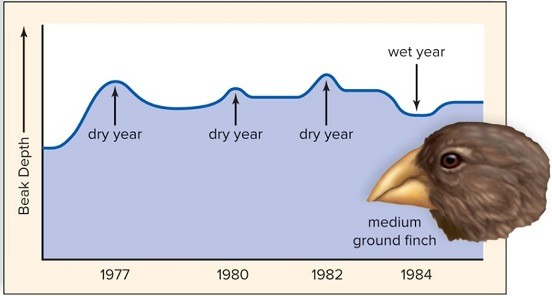Explain how the graphed data of beak size and weather conditions is evidence for natural selection. 
What will be an ideal response?
This graph depicts the relationship between beak size and weather conditions. This population of birds is "changing" in response to environmental changes. It is obvious that beak size is greater in drier years and less in wet periods. One might assume that weather conditions affected the food source of the ground finch and thereby favored a particular beak size that best used the food sources that were more plentiful in wet, as opposed to dry conditions. In fact, Peter and Rosemary Grant collected this data in 1973 as further evidence of natural selection. Under normal conditions, the finches prefer small, tender seeds that require a smaller beak size. Therefore, in wet years, the small-beaked birds are more successful reproductively. In drier weather, the finches must eat larger, drier seeds which are harder to crush. Therefore, larger birds are favored during this time and have more offspring. This is evidence of differential reproductive success in a changing environment.
You might also like to view...
The organisms occupying the base of a pyramid of energy are autotrophs
____________________ Indicate whether the statement is true or false.
Which of the following is a producer?
A. mushroom B. rabbit C. pine tree D. red-tailed hawk E. cricket F. earthworm
Which of the following is an example of flawed inductive reasoning due to availability bias?
A. Basing your assessment of the risk of a plane crash on television news reports. B. Basing your assessment of the risk of a plane crash on television news reports and determining the popularity of a government policy based on the opinions of your friends. C. Determining the popularity of a government policy based on the opinions of your friends. D. Believing the odds to be in your favor at a casino after winning the lottery.
The gas exchange surfaces in a mammalian lung are organized into structures that look like clusters of hollow grapes. The hollow, grape-like structures are the________.
A. alveoli B. lamellae C. parabronchi D. bronchi E. opercula